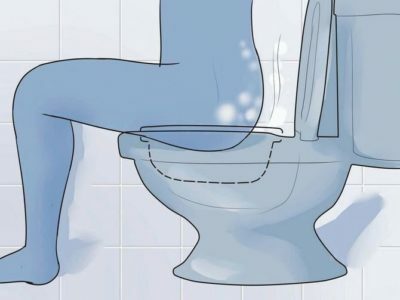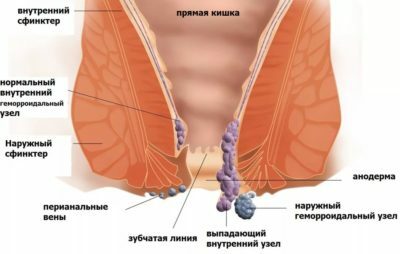1 What is this disease?
Thrombosis of hemorrhoids is the next stage of hemorrhoids. It occurs when there is no treatment or belated measures to fight hemorrhoids. Hemorrhoidal thrombosis has three degrees of severity:
Do you have hemorrhoids?
Mikhail Rotonov: "The only remedy that is suitable for the full treatment of hemorrhoids at home and which I could recommend is. .." Read more & gt; & gt;
- Blood clots appear due to a violation of the outflow of venous blood. Simultaneously, there is a violation of blood microcirculation in the nodes. Clogged vessels are not accompanied by inflammation, but the nodes begin to ache. Quite often, near the anus, painful bulges of small size appear, and the surrounding skin turns red. Painful sensations are still moderate, but the patient is constantly worried about discomfort, itching and burning.
- If the patient does not begin to be treated, inflammation develops. The hemorrhoidal nodes increase, the area of redness grows, and the tissues swell. The nodes themselves become very sensitive, and the pains intensify, which causes a spasm of the sphincter of the anus.
- At the most severe stage of the disease, a person is infected with tissues surrounding the anus, subcutaneous tissue and inguinal area. Edema and hyperemia of the skin are worse, often hemorrhoids are necrotic.
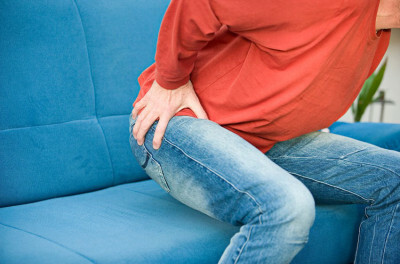
Recommended to read
- How to treat external hemorrhoids
- Treatment of hemorrhoids in pregnant women
- How to treat hemorrhoids at home
- Effective remedy for gastritis and stomach ulcer
2 Development of the disease
At the heart of the pathology is a violation of the functions of the vessels of the rectum. Because of stagnant phenomena, venous blood can not leave this area in time, as a result, veins begin to expand. This provokes the formation of hemorrhoids.
Further development of the disease causes them to fall out from the anus and clogged with blood clots.
There are a number of factors that lead to complications of hemorrhoids. So, the reasons are:
- A sedentary lifestyle and work related to a long stay in the sitting position: drivers, pilots, office staff, people involved in cycling and horse riding. Due to circulatory disorders in the pelvic region, stagnation and a violation of the outflow of venous blood occur.
- Steady work and heavy physical labor. Similar phenomena occur in people engaged in prolonged physical labor. This applies to weightlifters, loaders, locksmiths, builders, cooks, etc.
- Constipation and diarrhea. With chronic constipation, hard feces prevent the normal evacuation of venous blood. During the act of defecation, people who suffer from constipation, strongly strain, as when lifting the gravity. Diarrhea causes active irritation and inflammation of the rectum and anus, which is also an unfavorable factor.
- Smoking, alcohol and malnutrition. Smoking, salted, marinated, spicy and fatty foods irritate the intestinal mucous membranes. Alcohol leads to the expansion of blood vessels throughout the body, but stagnant phenomena in the pelvic organs prevent it from leaving normally, which provokes the expansion of veins and hemorrhoids.
- Pregnancy and childbirth. In pregnant women, the blood supply of the pelvic organs increases, but the growing fetus moves the veins, the outflow is disturbed, and the blood stagnates. When pregnant women often suffer from constipation, which, combined with physical stress during labor leads to the development of hemorrhoids and the prolapse of hemorrhoids.
- Inflammatory processes in the intestine and neoplasms in the organs of the small pelvis. Inflammation in the intestine leads to the development of spasm of the anus, compression and injuries of the veins of the rectum. The appearance of a tumor is accompanied by an increase in blood supply, but the veins can not cope with the evacuation of venous blood, which naturally leads to stagnation and widening of the veins.
-
 Doctors gasped! Kopecky treats Hemorrhoids instantly. ..Read more & gt; & gt;
Doctors gasped! Kopecky treats Hemorrhoids instantly. ..Read more & gt; & gt;
3 Symptoms of pathology
What are the symptoms of pathology? Against the background of dilated veins of the rectum, any physical effort can cause a rupture of the vessel in the region of the anus, and a blood clot will provoke a thrombosis of the external or internal hemorrhoids. When a blood clot presses on the walls of the vessel from the inside, irritation of the nerve endings occurs, and the brain interprets like pain. Constant pain in the area of the anus provokes a so-called duck walk.
The early stage of the disease is manifested by the burning and itching of the anus. Unfortunately, people run to the doctor only after the onset of bleeding, loss of hemorrhoids or the development of very severe pain. Initially, the discharge of blood is insignificant - a few drops on toilet paper or on stool after emptying the intestine. Without proper treatment, bleeding becomes regular and abundant.
Acute thrombosis of hemorrhoids and its main signs can be characterized as follows:
- Sudden unbearable pain in the anus. Most often, it occurs when injured or irritated veins are altered by hard cash registers. Because of a spasm of the sphincter, the dropped nodes can not be corrected, blood circulation is disturbed in them. They increase noticeably in size, become burgundy and swell.
- Bleeding. Usually bleeding opens after a mechanical trauma to the internal nodes. At a palpation veins firm and very morbid. Thrombosis of hemorrhoid nodes of the third degree is characterized by necrosis of tissues, bleeding surface of the nodes and small erosions.
- Thrombosis of the external hemorrhoidal node causes an unexpected increase in a small knob, previously unseen under the skin of the anus. The formation of thrombus and blockage are accompanied by severe pain, visible densification and swelling of the skin of the anus. Isolated edema with time grabs the entire groin area, which is accompanied by intolerable pain.
- Acute occlusion of the external hemorrhoidal node causes constant pain, in contrast to hemorrhoids, in which pain occurs only with physical effort and act of defecation. Thrombosis of hemorrhoids causes unbearable suffering when trying to empty the intestine, and restraining the stool increases constipation, thereby aggravating the situation.
- If you do not start treatment for thrombosis of hemorrhoids in time, the symptoms become very severe. Inflammation spreads from the anus in different directions, the skin during palpations is very sore, and carrying out a finger examination of the rectum is impossible because of a spasm of the sphincter. The skin above the hemorrhoids acquires a burgundy or purple color, necrotic areas appear on it. Absence of therapy leads to purulent paraproctitis and possible death of the patient.
ADVICE FROM THE MAIN GASTROENTEROLOGIST
Korotov SV: "I can recommend only one remedy for the rapid treatment of Ulcer and Gastritis, which is now recommended by the Ministry of Health. .." Read the reviews & gt; & gt;
4 Diagnostic measures
Since hemorrhoidal thrombosis is accompanied by a pronounced symptomatology, the diagnosis does not present difficulties for the proctologist. When examining the patient, visual examination, finger and instrumental examination are used.
When examining the anus, the doctor can see bulging purplish or cyanotic external knots. On their surface can be a whitish coating. If bulges on the bulges are visible, this indicates the development of necrosis or necrosis of the tissues. Skin around the thrombosed nodes edematic and hyperemic. Quite often blood from the affected tissues.
The palpation of the doctor examines the density of the nodes. Almost always with thrombosis, the nodes become denser and do not subside when pressed. If the spasm of the sphincter is not too strong, the doctor inserts a finger into the anus. At a thrombosis of internal knots on a glove it is possible to see bloody traces.
If the thrombosed nodes fall out, the patient is suffering very severe pain and spasm, so the examination can be done only after local anesthesia. Instrumental diagnosis is carried out using a rectal mirror, called a rectoscope. Rectoscopy is most often performed after local anesthesia. The procedure is designed to exclude anal fissure, polyp and rectal cancer. 
5 Complex medication therapy
Depending on the stage of the disease and the severity of tissue damage, the doctor will recommend conservative or surgical treatment.
Complex medication therapy includes medications, painkillers, absorbable gels and other methods for treating acute hemorrhoids, namely:
- Mandatory bed rest.
- A diet that excludes food that irritates the intestines, and is aimed at preventing constipation.
- If the condition allows, enemas are performed and laxatives are used.
- Cool sessile baths with decoction of chamomile or pale pink solution of potassium permanganate, as well as compresses, lotions and shower for the perineum.
- 4-5-time washouts of the anus with cool water.

6 Medications
Thrombosis of hemorrhoids 1 and 2 degrees of severity is treated with medicines. This therapy is aimed at:
- Elimination of local inflammation - ointments Levomekol, Levosin.
- Reducing pain and removing edema - Candles Anestezol. In some cases, alcohol-novocain blockades of the anus are made.
- Relaxation of the sphincter of the rectum.
- Thrombus destruction and prevention of new formation. To do this, topically apply ointments Troksevazin, Heparin, Gepatrombin or Gepatrombin G.
Many ointments and suppositories used in the treatment of hemorrhoids have simultaneously antibacterial, anti-inflammatory, antithrombotic and analgesic action: Proctosedil, Aurobin, Ultraprotect, Nigepan. Cream Posterizan has anti-inflammatory, wound-healing and local immunostimulating action, preventing secondary infection of erosion.
Tablets and ointments Detralex, Venarus, Venozol and Aescin are used to stimulate blood circulation, remove edema and increase the tone of the veins walls. Detralex reduces vascular permeability, tones the venous walls, and also reduces venous stasis and vessel dilatation. Aescin helps remove existing edema and improve microcirculation in tissues.
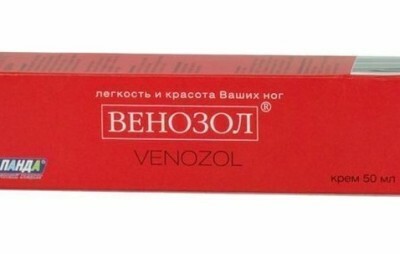
7 Surgical intervention
When conservative treatment does not help or thrombosis of hemorrhoids has reached stage 3, surgery is indicated. Urgent surgery is indicated for severe bleeding.
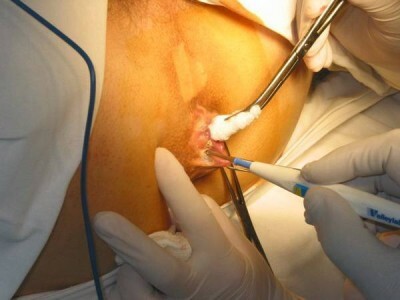
The simplest and fastest is a thrombectomy - this is the removal of the blood clot itself. The procedure is performed on an outpatient basis under local anesthesia. The surgeon dissects the exaggerated knot, the incision reaches 0.5 cm and cleans the thrombus. The operation takes no more than 5 minutes, as a result, the node falls off, and the patient gets rid of the pain and feels obvious relief.
Resection( removal) of the external hemorrhoidal node is a more complicated operation, but it relieves the patient of possible relapses. The operation does not require hospitalization and is performed under local anesthesia.
Modern medicine has minimally invasive methods for treating acute hemorrhoids: laser therapy, node ligation, infrared cautery and sclerotherapy.
8 First aid at home
It is possible to use folk medicine in the treatment of thrombosis of hemorrhoids only at an early stage of the disease. All the advice you like is better discussed with your doctor. Treatment at home can include the following recipes:
- Sitting baths with birch broth. Take 100 g of birch leaves and pour 2 liters of boiling water, leave for about an hour. Strain and drain the liquid into the basin.
- Leeches. Buy a leech in the pharmacy and put one on each serving knot. After saturation the leech will disappear itself, and the inflamed knot will decrease in size and wither.
- Birch tar. In the fight against inflammation of the hemorrhoids, ointment with birch tar and anal swabs impregnated with this remedy are often used.
Thrombosis of hemorrhoids is a frequent complication of hemorrhoids. He causes severe pain and inconvenience, which will certainly force a person to be treated. Early treatment will allow you to limit your medications and avoid surgery.
- 1 What is this disease?
- 2 Development of the disease
- 3 Symptoms of the pathology
- 4 Diagnostic measures
- 5 Complex medication therapy
- 6 Medications
- 7 Surgical intervention
- 8 First aid at home
Treatment of hemorrhoids at an early stage is not very difficult, but with complications, thrombosis of the hemorrhoidal node begins. As a result, a person suffers constant pain in the anus, which adversely affects the quality of life and requires an urgent intervention of the proctologist.

